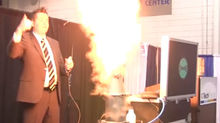Breathing Air Supply Choices
Using the right respirator equipment makes sense, not only from the safety aspect, but also considering hygiene, morale, productivity, and profitability.
Blasting respirators (as well as all “air-fed respirators”) are lightly pressurized with fresh air. They are commonly powered by remotely located breathing air compressors or ambient air pumps. This article will cover the differences and benefits of each, and address some of the issues I find when training customers.
Respirators used for blasting need to be of the “Type CE” variety, which are certified by NIOSH (that is, OSHA) specifically for abrasive blasting. Styles that are not Type CE should never be used for blasting.
And, yes, if you are blasting anything with any type of media or machine, you do need a blasting respirator. (Ref OSHA 1910.94a5I / 1910.94a5II / 1926.57ffi / 1926.57f5ii) That should apply to anyone in the vicinity, for that matter – since the dusts produced often contain toxins or large quantities of “nuisance dust.” For example, one common contaminant is hex chrome, with a newly established OSHA Permissible Exposure Limit of 0.5 microgram per cubic meter - and an Action Level half that. That’s truly infinitesimal! (Google “Hex Chrome” for an enlightening dialogue.)
Your air source needs to be Grade D. In simplest terms, that means nothing more than clean, breathable air, but it does require specific amounts of oxygen (etc.), and limits on specific unhealthy contaminants. (Google “Grade D Air” for more info.)
Key safety pointer: The remote air intake for your breathing air cannot be located near truck or engine exhaust – the CO (carbon monoxide) gas that either emits can be deadly. CO is odorless and tasteless – so beware!
One of my customers who is really on-the-ball placed a sign near the intake of his breathing air, and I have posted it here, with permission, for all to benefit.
Considerations when using breathing air compressors:
Note that compressors degrade the quality of the air they produce. Rust and other contaminants can enter the airstream. The compressor itself can produce CO gas. Unwanted vapors and particulate must be removed before you breathe it. That requires a special “Personal Air Filter.” And to monitor compressed air for carbon monoxide, a CO Monitor has to be used (ref: OSHA 1910.134i7). Both of these devices must be maintained periodically. A multi-stage personal air filter cartridge, like the 41 Series carried by Dawson-Macdonald, removes byproducts including water, oil, particulates, odors and organic vapors.
Dawson-Macdonald sells a unique filtration system that removes carbon monoxide gas, as an upgrade. But don’t think that a typical filtration device will make Grade D air out of non-Grade D air. They will only filter out those contaminants specifically stated by the manufacturer.
A common question is, “When do you change out the filter element?” Answer: When the user can detect smells, and as recommended by the respirator’s manufacturer – and that might be as often as 90 days. How often do you have to recalibrate a remote CO monitor? Typically, monthly. In either case, check the manual and keep a log in case OSHA shows up.
Be sure you research which kind of CO alarm makes sense for your location’s monitor. Audible, remote audible, and strobe are some of the options.
We sometimes read about operators who accidently hook up their breathing air’s quick disconnect fitting to a hard-piped gas, such as those used in welding. (See my link on Twitter for one tragic example.) For that reason, be sure that the style of quick disconnect fitting that you use for breathing air is physically incompatible with all of your plant’s process gases’ attachment points. Workers have died, including recent cases. We offer Industrial Interchange (Hansen), Schrader, and Snap-Tite fittings to convert deficient setups so you can be sure this tragedy never strikes your business.
With all the cautions about breathing compressed air, what are the benefits? From my point of view, the standout is air conditioning and heating capability. The high-pressure air entering an air-fed respirator can be heated in the winter or chilled in the summer by up to 40-degrees F. All that takes is screwing into place a next-generation accessory that has no moving parts. That makes for a worker with better morale who can concentrate on the work at hand for hours at a time. And the increased productivity produces profits for you.
Considerations when using an ambient air pump:
An ambient air pump (such as Bullard’s EDP-10 Free-Air® Pump) is a motorized low-pressure air pump that supplies the respirator through a suitably sized breathing hose. Ambient air pumps are simple and, since the device does not compress air to the point of condensing appreciable amounts of water, you do not need high levels of filtration. With an ambient air pump, OSHA does not require a CO monitor – and that saves cost and eliminates the need for monthly calibration.
An ambient air pump has an inlet filter and outlet filter that must be replaced, and oftentimes this is not done frequently enough. Typically, the inlet filter has to be changed every 500 hours and the outlet filter every 200 hours, or as conditions warrant (see your operating manual for details).
The Free-Air pump is durable and easy to maintain. A rebuild kit and safety solvent are available for that infrequent task.
Ambient air pumps have been hooked up to specialized ice boxes, but this is much less popular. We sell a remarkable cooling vest for workers using the Ambient air pump in the warmer months, where the temperature is maintained at 55-degrees F for hours to reduce worker’s heat stress. Recharging takes just minutes.
Either way you go, remember:
Both the 41 Series personal air filter and Free-Air pump (and their competitive alternatives) feature the “point-of-attachment” (POA) that is mandated for connection of the breathing hose. That is, essentially, a regulator and gauge. The respirator starts at the POA. From that point onward, every component must be of the same manufacture, and real “breathing air” hose is an essential element.
Aftermarket parts may be marginally cheaper, but they violate the NIOSH certification that the respirator system is safe*. So if you use a Bullard respirator, use genuine Bullard replacement lenses in the helmet. Same for air hose, fittings, everything. Genuine parts carry the name of your system’s manufacturer. Using non-OEM parts can lead to an OSHA citation.
Do wear appropriate hearing protection and safety eyewear. And don’t share respirators without a thorough cleaning. Better yet, assign each worker his own respirator helmet, and hold them accountable for its condition. And follow the operating manual to the letter.
If you are not currently using a Type CE respirator for blasting, prepare to have fresh, clean air, cooler conditions, and better – fog-free – visibility. Using the right respirator equipment makes sense, not only from the safety aspect, but also considering hygiene, morale, productivity, and profitability.
We are available to help.
Dawson-Macdonald offers several brands of respirator systems, each with unique attributes. Each is a highly personal choice with many considerations. We will work with you to recommend the best system for your particular operators and needs.
For my regional customers, I am always available for consultation and training. I make use of an excellent video that is produced by Bullard to increase awareness and safety, followed by a lively question and answer session that is very enlightening.
In future BlastPrep.com blog articles, I will cover other important aspects of respiratory protection, especially as it concerns blasting, painting, and powder coating workers. And, stay tuned for exciting developments on a new Type CE style blasting respirator!
Tip: Many customers have found that the supplied-air “soft-shell” respirators we carry offer significant benefits for painting, powder coating, metalizing, and other uses (we will cover those in a later article). Either blasting or painting respirators can use the same style air source and breathing air hoses, and that commonality cuts down on spare parts, cost, and training.
*NIOSH specifically cautions that “…respirators which have been modified by the interchanging of subassemblies or other deviations using parts not produced and distributed under the respirator manufacturer’s controlled system, no longer meet the definition of being approved as NIOSH-certified respirator…”
Warnings: Respiratory protection is an extensive topic, so the above “overview” should not be construed as comprehensive – particularly when it comes to breathing compressors and ambient air pumps. System maintenance can’t be overstated. Use OEM parts that make for a complete “certified system” as intended by the manufacturer and NIOSH (OSHA). ONLY devices that specifically state that they remove CO do (when properly maintained, that is). A Personal Air Filter and an ambient air pump do NOT remove CO. Additional research, including consulting your EHS manager, hygienists, insurance carrier, regulators, and your respirator’s manufacturer is highly recommended. Read and understand the operating manual for your breathing air system prior to use, taking into account all warnings as well as common sense practices.
© Mark Hanna 2014 All rights reserved.



































